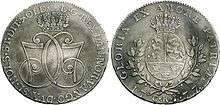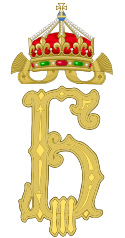Monogram

A monogram is a motif made by overlapping or combining two or more letters or other graphemes to form one symbol. Monograms are often made by combining the initials of an individual or a company, used as recognizable symbols or logos. A series of uncombined initials is properly referred to as a cypher (e.g. a royal cypher) and is not a monogram.[1]
History

Monograms first appeared on coins, as early as 350BC. The earliest known examples are of the names of Greek cities who issued the coins, often the first two letters of the city's name. For example, the monogram of Achaea consisted of the letters alpha (Α) and chi (Χ) joined together.[2]
Monograms have been used as signatures by artists and craftsmen on paintings, sculptures and pieces of furniture, especially when guilds enforced measures against unauthorized participation in the trade. A famous example of a monogram serving as an artist's signature is the "AD" used by Albrecht Dürer.
Christograms
Over the centuries, monograms of the name of Jesus Christ have been used as Christian symbols. The IX monogram consists of the initial Greek letters of the name "Jesus Christ," "I" for Ιησούς, (Jesus in Greek) and "X" for Χριστος (Christ in Greek). The "IHS" Christogram, denoting the first three letters of the Greek name of Jesus, is usually written as a cypher, but sometimes as a monogram. Perhaps the most significant Christogram is the Chi Rho, formed from the first two letters of Χριστος.
Royal monograms

Signum manus (sometimes also known as Chrismon) refers to the medieval practice, current from the Merovingian period until the 14th century in the Frankish Empire and its successors, of signing a document or charter with a special type of monogram or royal cypher.

Monograms of the names of monarchs are used as part of the insignia of public organizations in kingdoms, such as on police badges. This indicates a connection to the ruler. However, the royal cypher, so familiar on pillar boxes, is not technically a monogram, since the letters are not combined.
Royal monograms often appear on coins, frequently surmounted by a crown. Countries that have employed this device in the past include Bulgaria, Great Britain, Russia, Sweden and many German states. Today, several Danish coins carry the monogram of Margrethe II, while the current Norwegian 1 Krone coin has the "H5" monogram of Harald V on the obverse.[3] The only countries using the Euro to have a royal monogram as their national identifying mark are Belgium and Monaco.[4] In Thailand royal monograms appear on the individual flag for each major royal family member.
Individual monograms

An individual's monogram is often a very fancy piece of art used for stationery, for adorning luggage, for embroidery on clothing, and so forth. These monograms may have two or three letters.
A traditional 3-letter monogram has the initial of the individual's last name (surname) set larger, or with some special treatment in the center, while the first name initial appears to the left of it and the middle name initial appears to the right of it. For example, if the individual's name is Mary Ann Jones, and Jones is the surname, then the arrangement of letters would be thus: MJA, with the surname initial set larger in the center, the M for Mary to the left and the A for Ann to the right.[5]
Married or engaged couples may use two-letter monograms of their entwined initials, for example on wedding invitations. Married couples may also create three-letter monograms incorporating the initial of their shared surname. For example, the monogram MJA might be used for Michael and Alice Jones.[5] However, monogramming etiquette for the married couple varies according to the item being monogrammed. Linens, for example, typically list the woman's given initial first, followed by the couple's shared surname initial and then the man's given initial (AJM).[6]
Monograms can often be found on custom dress shirts where they can be located in a number of different positions.
Other monograms

Some companies and organizations adopt a monogram for a logo, usually with the letters of their acronym. For example, as well as having an official seal, and the Texas Longhorns logo, the University of Texas at Austin uses a "UT" monogram (in the same color as the Longhorns logo, burnt orange). The New York Yankees baseball team also uses a monogram on their ball cap insignia and French soccer team Olympique de Marseille use a monogram tooken from in funder. The Consolidated Edison logo, with a rounded "E" nested inside a "C," has been described as a "classic emblem."[7]
Many fashion companies have a monogram for a logo, including Louis Vuitton and Fendi. The connected "CC" company logo, created by Coco Chanel, is one of the most recognizable monograms internationally.[6]
Athletes have also been known to brand merchandise with their monogram logo; notably Tiger Woods and Roger Federer.[8]
Resistance symbols in wartime

A notable example of a royal monogram is the H7 monogram of King Haakon VII of Norway. While in exile during World War II, Haakon VII spearheaded the Norwegian resistance to the German occupation, and H7 became a symbol used by the Norwegian populace to mark solidarity and loyalty to the King, and adherence to the Norwegian resistance movement. The act of drawing or creating a H7 symbol in German-occupied Norway was punishable by imprisonment.[9]
Similarly, during World War II in Poland, the "PW" monogram was used as a resistance symbol, known as The Anchor, or Kotwica due to its characteristic shape. Its meaning varied, as the initials were useful for many different slogans, such as Poland Fights, Warsaw Uprising, Polish Army and others. Like the Norwegian example above, its use was punished by the Nazi occupation authorities.
Japanese
- Monograms selection
 Logo on cover of 1896 edition of The American Claimant by Mark Twain
Logo on cover of 1896 edition of The American Claimant by Mark Twain Napkin with embroidered monogram
Napkin with embroidered monogram SPQR, detail from the mosaic floor in the Galleria Vittorio Emanuele II
SPQR, detail from the mosaic floor in the Galleria Vittorio Emanuele II Monogram of Pedro II, Emperor of Brazil
Monogram of Pedro II, Emperor of Brazil
See also
- Signum manus
- Interrobang
- Kaō
- Ligature
- Varsity letter
- Nicolas Verrien, 17th century French monogram designer
References
| Wikimedia Commons has media related to Monograms. |
- ↑ The Shorter Oxford English Dictionary (Fifth edition; 2002) defines it as a "device composed of two or more letters... interwoven together." Volume 1, p. 1820.
- ↑ Henry Noel Humphreys, The Coin Collector's Manual, Or Guide to Numismatic Student in the Formation of a Cabinet of Coins (Bibliolife, 2008), 226.
- ↑ Coins, at the Norges Bank website.
- ↑ A commemorative €2 coin from Luxembourg carried the monogram of Grand Duke Henri.
- 1 2 Jeanine Twigg, Embroidery Machine Essentials: How to Stabilize, Hoop and Stitch Decorative Designs, KP Craft, 2001, ISBN 0-87341-999-5, p. 43.
- 1 2 "What is a Monogram?". Retrieved 2015-07-02.
- ↑ BusinessWeek online, Con Ed: The Power of a Logo, 11 August 2005.
- ↑ Brubach, Holly (August 29, 2009). "The Main Characters of Tennis, and Style". New York Times. Retrieved 21 August 2014.
- ↑ Hjeltnes, Guri (7 April 2008). "Meldinger fra Norge". VG (in Norwegian). p. 2.

